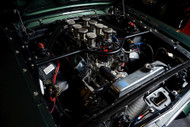How to Replace Your Vehicle's Thermostat
18th Jul 2019

Vehicle Thermostat
If your vehicle has a faulty thermostat, you should replace it immediately to protect against potentially catastrophic engine damage. As you may know, the thermostat is responsible for regulating the flow of coolant through your vehicle's engine. When you initially start your vehicle, the thermostat will remain closed, allowing your engine warm up. And once the engine has achieved a "normal operating" temperature, the thermostat will open.
Unfortunately, it's not uncommon for automotive thermostats to fail. Some thermostats may get stuck in the open or closed position, neither of which is good. If your vehicle's thermostat is stuck open, the engine won't be able to heat up, which can adversely affect the way in which oil flows through the crankcase. If the thermostat is stuck closed, the engine won't be able to cool down, which can lead to overheating.
Repairing vs Replacing a Thermostat: Which Is Best?
Whether your vehicle's thermostat is stuck open or closed, you might be wondering if it's possible to repair it. After all, most automotive components can be repaired, so conventional wisdom may lead you to believe that you can repair a broken thermostat as well.
Thermostats are difficult to repair, however, because of the way in which they are designed. Thermostats work by opening or closing automatically depending on the temperature. As a result, you can't easily repair a broken thermostat. But the good news is that you can typically replace this component using just a few basic tools.
Steps to Replacing a Thermostat
To replace a broken thermostat, wait until your car is completely cool and carefully open the radiator cap. Next, use a screwdriver or socket wrench to remove the radiator hose next to the thermostat. In some vehicles, the thermostat is located next to the top hose. In others, it's located next to the bottom hose.
Before pulling the hose off, place a bucket or pan underneath to catch the coolant. Once the hose is off, pull the thermostat out of the housing unit. You can then install the new thermostat in the housing, followed by securing the radiator hose back in place. When you are finished, refill your radiator with coolant and bleed out any trapped air.
Test After Installing
It's a good idea to test your new thermostat after installing it. To see if the thermostat works, crank your vehicle and watch the temperature gauge. If it works, the temperature gauge should climb to just under the halfway mark. If the thermostat is still stuck open, it will likely remain well below this level. If it's stuck closed, it will climb past the halfway mark, indicating that your engine is overheating.

